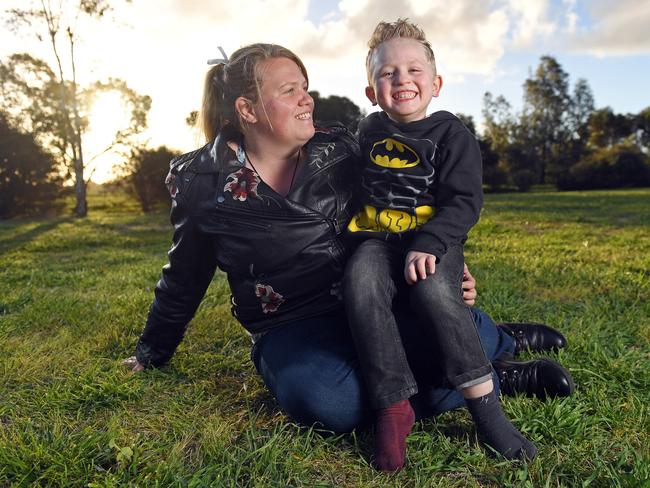Asthma hospital treatment rate in Adelaide is the highest in Australia
SOUTH Australian children with asthma are being rushed to hospital at an alarming rate, the highest in the nation, and new research will investigate the reasons why.
SOUTH Australian children with asthma are being rushed to hospital at an alarming rate, the highest in the nation, and new research will investigate the reasons why.
The first State of Asthma in South Australia report, to be released today, also reveals the total hospitalisation rate is higher than the national average.
Asthma Australia chief executive Michele Goldman says people living with asthma need to better understand their condition and take prevention seriously, rather than relying on their blue reliever.
“Reliever medication is a Band-Aid solution,” she said.
“It does provide immediate relief, but it does nothing to address the underlying inflammation in the airways, so you continue to be susceptible to symptoms and a serious flare up that could land you in hospital.”
Of the 5754 cases presenting to SA emergency departments with asthma in 2016-17, one third was avoidable.
“So it’s really critical we get the message out there that we have good preventer medications on market, many of them are available on the PBS,” Ms Goldman says.
“The best way to stay healthy and well and almost not notice you have asthma is to take preventer medication daily.

“We encourage people to keep it next to their toothbrush so it becomes a daily habit, so that people can just get on with life and be productive contributing citizens.”
More than one in ten South Australians have asthma, about 173,100 people.
The prevalence is higher in regional areas, where people are also 36 per cent more likely to be admitted to hospital with asthma.
It’s possible dry and dusty conditions are to blame, but there are many triggers and different people respond in different ways.
When it comes to children, the answer to the “magic question” of why so many are going to hospital is “probably a combination of factors because asthma is a complex disease”, Ms Goldman says.

Asthma Australia is supporting research at the Queen Elizabeth Hospital to explore that question in detail, with respiratory medicine director Dr Brian Smith.
In 2016, asthma caused the deaths of 45 people in SA. Asthma Australia says about 70 per cent of those deaths may have been prevented.
“Good asthma management is the goal,” Ms Goldman says.
“We need to provide people with ongoing advice, an asthma action plan, regular asthma check-ups with their GP, and taking preventer medication as prescribed.”
SA children have the highest hospitalisation rate in Australia with 361 children per 100,000 population admitted to hospital in SA, which is much higher than the Australian average (309).
However the report also found 68 per cent of children with asthma in SA have an Asthma Action Plan, compared to 36 per cent of the total population.
Four-year-old Marley was admitted to hospital in May when he suffered his first asthma attack.
Mum Ellen Heinze-Faulkner of Gawler Belt had a “puffer” (reliever medication) at home just in case, because he had eczema as a baby and the two often go together. It gave some relief but his breathing kept getting worse throughout the day until he became “pasty-white and couldn’t move his arms, let alone his legs”.
“We took him to hospital and he was pretty freaked out, but he was given medication and oxygen and they kept him in for 24 hours until he stabilised,” she said.
“I didn’t really know much about asthma, so when we were leaving I asked the doctors what I could do as a parent, they referred me to Asthma Australia’s COACH program.
“Our asthma educator, Clara has been an absolute godsend. The advice and information she’s given has been so helpful.”
Marley is now taking preventer tablets first thing in the morning.
“As long as he has those he’s pretty much OK and then every now and then he may need his puffer,” Ms Heinze-Faulkner said.
Minister for Health and Wellbeing Stephen Wade will launch the report this morning.
Asthma Week is held in the first week of September each year to raise awareness of the condition.
Summary of findings
• More than one in ten (10.6%) of South Australians have asthma, which is about 173,100 people.
• Asthma prevalence is higher in regional areas of South Australia (12.6%) than in Greater Adelaide (10.3%).
• People in regional South Australia were 36% more likely to be admitted to hospital with asthma than South Australians living in Adelaide.
• 145.5 per 100,000 South Australians were hospitalised due to asthma in 2014/15, the third highest rate in Australia.
• There were 5754 Emergency Department presentations for asthma in South Australia in 2016-17 and one-third of these are avoidable.
• South Australians are more likely to possess an Asthma Action Plan than people interstate.
• 68% of children with asthma in South Australia have an Asthma Action Plan.
• 36% of South Australians with asthma have an Asthma Action Plan.
• South Australian children are more likely to be admitted to hospital because of asthma than children from any other Australian state or territory.
• A total of 361 children per 100,000 population in South Australia were admitted to hospital, which is much higher than the Australians state/ territory average (309).
• Asthma caused 45 deaths in South Australia in 2016.
UNDERSTANDING ASTHMA
Any degree of asthma symptoms can lead to an asthma flare-up, and any asthma flare-up can lead to a life-threatening episode.
People with asthma usually need to take a daily preventer-class medication to avoid symptoms and always need to carry a reliever-class medication in case symptoms occur.
Unfortunately many people with asthma don’t receive treatment in accordance with their clinical condition.
Of those prescribed a preventer medicine, approximately 90% don’t use it as prescribed.
Of those that use preventer medicine, approximately 90% don’t use their device correctly.

